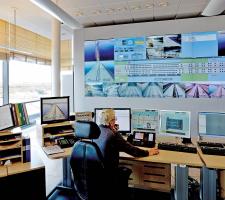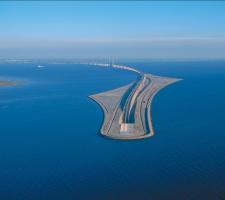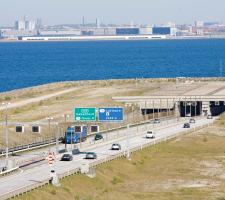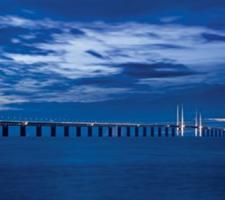
Timothy Compston considers the challenges faced by the operators of the Øresund Bridge between Denmark and Sweden, the largest structure of its kind across Europe.
In light of the concerns about the ongoing security threat and the unprecedented flow of migrants, many of the countries that make up the Schengen Area in Europe have re-introduced border controls. For its part, Sweden has rolled out ID checks for train, bus and ferry passengers from Denmark placing the landmark Øresund Bridge very much on the frontline of these changes.
By any measure, the Øresund Bridge - which first opened back in 2000 - is an impressive structure carrying four lanes of the E20 (two in each direction) and a rail line between the Danish capital Copenhagen and the city of Malmö in Sweden. The bridge structure spans nearly 8km (5 miles) from the Swedish coast to the artificial island of Peberholm where the roadway enters the 4km (2.5-mile) Drogden Tunnel to the Danish island of Amager and carries 18,000 - 19,000 vehicles each day.
The two governments hold a 50:50 stake in the project and the Øresund Bridge organisation says it is ‘an integrated Danish-Swedish enterprise where Swedes and Danes use both languages.’ There is a single traffic monitoring centre responsible for running the toll station, monitoring traffic and technical systems. It is part of the link’s operations centre (which also includes the bridge’s administration) and is sited just outside Malmo on the Swedish side of Oresund where the toll station is also located.
Border Checks
So what is it like having responsibility for monitoring one of the world’s largest bridge and tunnel combinations and what was the impact of the heightened checks on Sweden-bound travellers? Jopas Wulff, traffic manager with the Øresund Bridge, is the man with the answers and recalls that the implementation of the border controls by the toll booths at the Swedish end was fast-tracked and effectively came in overnight. The police, having routinely checked random vehicles, started checking all vehicles.Rail passengers were checked at Copenhagen airport and Hyllie, the first station in Sweden after the crossing.
Initially, the Danish police were concerned about how the new controls would impact the toll station: “They imagined big issues with congestion all over the bridge and down to the tunnel and that they would have to shut the highway down at the airport.”
However Wulff reckons that this worst-case scenario has not materialised: “We do have some congestion in the rush hours between three and six but the police are manning up so they have the resources down at the toll station.”
He says that, by contrast with the road situation, there are more headaches for those travelling by train, especially for commuters returning from Denmark: “If you are on a train you have to get off at Kastrup station, go through a manual ID check and then board another train to Sweden. It takes more time, there are delays, and the trains don’t go as often as they used to.”
Asked about how long he believes that the additional border checks are likely to remain in place around the bridge, Wulff reckons that it is going to be for some time to come: “We don’t expect it [the border checks] to end this summer, it is going to be for at least a year more. The cooperation between the police at the border control and our control room is now very good. If they [the police] have to do something to make the process go a bit faster they oblige,” explains Wulff.
When individuals fail the new border checks, Wulff reveals that some are still determined - whatever the hazards - to try again and walk on the highway to reach the tunnel to Sweden: “So far when we have seen this they have been taken care of by the Danish police and we fire up warning signs for drivers to prevent an incident.”
He adds that urgent remedial action is in the works so that migrants - or other individuals - don’t have an opportunity to sneak through the railway tunnel whose entrance, he admits, has been a surveillance weak link. The project will see the positioning of new IR and thermal cameras at the tunnel’s entrance to detect people moving in the area.
Beyond the recent changes at the border, Wulff outlined some of the long-standing issues the Øresund bridge has faced from a traffic management perspective and how these have been addressed along the way: “The key challenge facing us above anything else is to keep the traffic running as this [the Øresund Bridge] is the major connection between Sweden and Denmark. About 83% of all road traffic goes by this link,” says Wulff.
If there is an interruption in the traffic flow due to an accident or a lane closure, the reality is that there are no easy options for drivers besides taking a 60km detour north to board a ferry: “Even then the ferry doesn’t have the capacity to take all the vehicles we carry. So it is very, very, important for us to have fluid, smooth-flowing, traffic running across the bridge at all times.”
Given just how vital the Øresund Bridge has become as an indispensable transport corridor for the wider region, Wulff says that the onus is very much on his team to work proactively with regards to traffic surveillance and traffic management: “We have nine operators that manage one position 24/7. This is a good number and means that we can manage training, vacation times, and sickness.” One striking change to the control room, technology-wise, to make life easier for the operators, reports Wulff, has been the installation of a number of new modern video screens from Barco to form a video wall.
Returning to the type of situations which the control room is set up to manage on a daily basis, Wulff stresses that if there are indications that a car has stopped in the tunnel - or on the bridge - it is imperative that action is taken immediately: “We don’t just let an incident run itself. We make sure that the car, for example, is taken away as fast as possible so we don’t have something that may distract other customers [drivers].
Otherwise it is very usual that you might have what is called a ‘looking accident’, if we can prevent this that is a major step.”
Talking more about the type of response that can be brought to bear should something happen to disrupt traffic flow or impact on safety, Wulff says that it really depends on whether the situation occurs on the bridge or in the tunnel.
If it is on the bridge there are “a few different options”, and vehicles are generally removed within 45 minutes but in the confined space of the tunnel, incident response is ramped up, considerably. “If a car stops in the tunnel, because we don’t have the escape lanes you would find on a typical highway, then that is classified as an accident. It is not an accident where we send ambulances but within five minutes we would send a tow truck and the police and protection vehicles for the tow truck to work safely.”
Incident Detection
Even before the most recent border developments, systems were in place to detect unusual activity. A Traficon video-based incident detection system was installed for the opening of the link in 2000 and this has subsequently been upgraded with a newer version of the system. Wulff comments on the changes in the video analytics technology over that intervening period saying: “This makes the systems today much more sensitive and capable of detecting different sorts of obstacles and issues.”In practice the application of the detection system differs markedly between the bridge and tunnel: “On the bridge there are just some spots where we can detect cars that drive the wrong way but in the tunnel we have 100% coverage for these ‘ghost drivers’ as well as fallen objects, pedestrians, slow moving vehicles and stopped vehicles. We also have some redundancy so if one camera doesn’t work the nearest cameras can cover that area.”
The main cause for ‘ghost drivers’ on the Øresund Bridge is because drivers realise too late that they are on their way to Sweden - despite signs forewarning them that they are approaching the last Danish exit: “People miss that exit and when they come down to the tunnel say ‘I’m not supposed to be here’ and put their car in reverse - which is very dangerous for other road users - and get detected by the detection system.”
While additional signs have been added, Wulff says the effect has been limited. Part of the rationale for this, he says, is that if there are too many signs then experience shows people do not read them all: “It is much better to have fewer signs and a clear message,” he says.
One demonstration of the ‘quality not quantity approach are the plans to replace and upgrade Øresund’s dynamic road signs: “At the moment we don’t get the response we would like. We are planning on removing the signs we have and using slightly bigger information signs with more pictures that say what is further ahead to put more responsibility on drivers.” Wulff says there will be fewer signs but “there will now be information signs that can tell drivers if a car is stopped about 3km ahead and to take appropriate measures and things like that.”
Driving ahead, with all of the measures that are already in place, or in the works, the ITS infrastructure at the Øresund Bridge is well-placed to cope with the changing dynamics of traffic in and around the structure, whether as a consequence of new border control arrangements, vehicles deciding to travel the wrong way, or simply a car breaking down.
About the Author: Timothy Compston is a journalist who writes on traffic technology and security issues
















